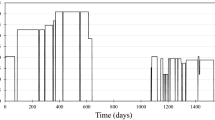Abstract
The radioisotope 129I (half life, t½=1.57×107 yr) offers the possibility of extending the time span over which cosmogenic radioisotopes can be used to study extraterrestrial and terrestrial phenomena. Its half life falls between that of 53Mn (3.7×106 yr) and 40K (1.28×109 yr) in a region where interesting effects can be expected. The target elements for z>28 are normally present in low concentration in natural materials, making detection difficult. We report here the first precise measurements of 129I in extraterrestrial materials: three meteorites of different classes and one lunar surface rock.
This is a preview of subscription content, access via your institution
Access options
Subscribe to this journal
Receive 51 print issues and online access
$199.00 per year
only $3.90 per issue
Buy this article
- Purchase on Springer Link
- Instant access to full article PDF
Prices may be subject to local taxes which are calculated during checkout
Similar content being viewed by others
References
Edwards, R. R. Science 137, 851–853 (1962).
Kohman, T. P. Carnegie Institute of Technology Prog. Rep. NYO-884-71, 50–62 (1967).
Lindstrom, R. M. thesis, Univ. Calif., San Diego (1970).
Imamura, M. & Horie, K. Symposium on Radiochemistry, Nigata, Japan, 1972 (abstract in Japanese) (The Chemical Society of Japan, 1972).
Elmore, D. et al. Nature 286, 138–140 (1980).
Bowman, D. & Heffer, R. H. Nucl. Instrum. Meth. 148, 503–509 (1978).
Wacker, J. F. & Marti, K. Earth planet. Sci. Lett. 62, 147–158 (1983).
Schultz, L. & Kruse, H. Nucl. Track Detection 2, 65–103 (1972).
Lugmair, G. W. & Marti, K. Proc. 3rd Lunar Sci. Conf., 1891–1897 (1972).
Nishiizumi, K. et al. Earth planet. Sci. Lett. 50, 156–170 (1980).
Ikramuddin, M. et al. Geochim. cosmochim. Acta 40, 133–142 (1976).
Ngo, H. T. & Lipschutz, M. E. Geochim. cosmochim. Acta 44, 731–739 (1980).
Mason, B. Handbook of Chemical Abundances in Meteorites (Gordon and Breach, New York, 1971).
Goswami, J. N. Earth planet. Sci. Lett. 62, 159–164 (1983).
Cressy, P. J. Jr. J. geophys. Res. 77, 4905–4911 (1972).
Morgan, J. W. et al. Proc. 3rd Lunar Sci. Conf., 1377–1395 (1972).
Taylor, S. R. et al. Proc. 3rd Lunar Sci. Conf., 1231–1249 (1972).
Hohenberg, C. M. et al. Proc. 9th Lunar planet. Sci. Conf. 2311–2344 (1978).
Berdot, J. L. et al. Proc. 3rd Lunar Sci. Conf., 2867–2881 (1972).
Clarke, R. S. Jr. et al. Smithson Contr. Earth Sci. 5, 1–53 (1970).
Author information
Authors and Affiliations
Rights and permissions
About this article
Cite this article
Nishiizumi, K., Elmore, D., Honda, M. et al. Measurements of 129I in meteorites and lunar rock by tandem accelerator mass spectrometry. Nature 305, 611–612 (1983). https://doi.org/10.1038/305611a0
Received:
Accepted:
Issue Date:
DOI: https://doi.org/10.1038/305611a0
This article is cited by
-
Mass-spectrometric determination of iodine-129 using O2–CO2 mixed-gas reaction in inductively coupled plasma tandem quadrupole mass spectrometry
Analytical Sciences (2022)
-
Speciation analysis of 129I in seawater using coprecipitation and accelerator mass spectrometry and its applications
Journal of Radioanalytical and Nuclear Chemistry (2017)
-
Determination of129I in low level radioactive waste by radiochemical instrumental neutron activation analysis
Journal of Radioanalytical and Nuclear Chemistry Articles (1995)
Comments
By submitting a comment you agree to abide by our Terms and Community Guidelines. If you find something abusive or that does not comply with our terms or guidelines please flag it as inappropriate.



